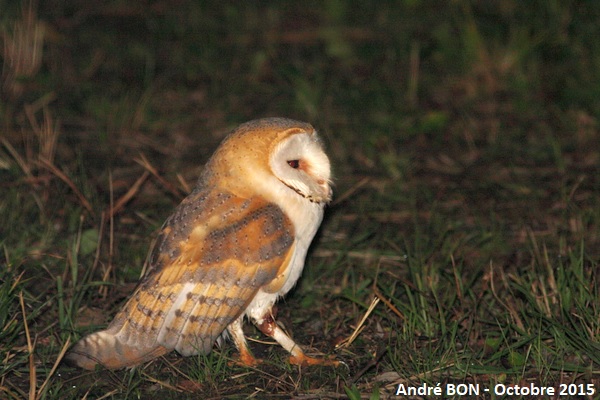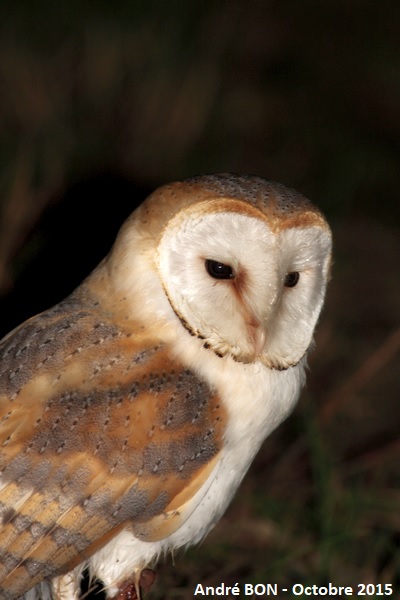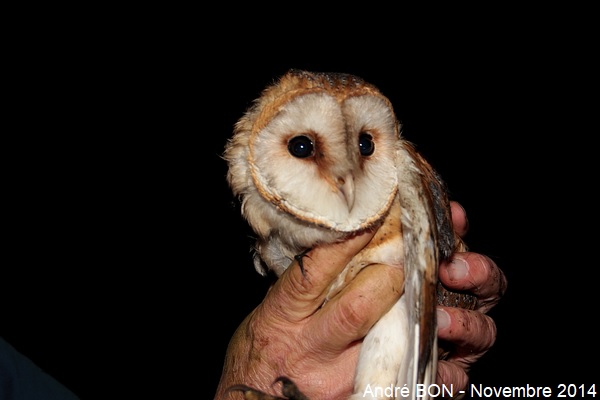






| Western Barn Owl (Tyto alba (Scopoli, 1769)) |







|
|
Scientific name: Tyto alba (Scopoli, 1769) Common name: Western Barn Owl French name: Effraie des clochers, Chouette effraie, Dame blanche. Order: Strigiformes Family: Tytonidae Size: Body size: 32 to 40 cm; Wingspan: 75 to 110 cm; Weight: 190 to 455g (in Europe). Females are slightly larger than males. Habitat: Open areas with sparse trees, barns, stables, steeples, ruins. Food: Mainly small rodents captured at night thanks to its silent flight and localized using its facial discs which collect sounds like parables. Barn Owls can also capture a few birds and large insects. Preys are completely swallowed, indigestible parts are rejected in rejection balls. Nesting: Western Barn Owls nest in natural holes or in buildings. Nests are lined with rejection balls. There are one or two clutches per year with 4 to 7 eggs and sometimes many more. This numerous reproduction makes it possible to compensate for the high mortality rate among juveniles. Migration: Sedentary. Some moves may happen in case of lack of food. Geographic area: Worldwide except polar areas. There are more than 30 sub-species, let's mention Tyto alba alba which is found in Western Europe and around the Mediterranean Basin, Tyto alba guttata which is found from eastern France to western Russia, Tyto alba pratincola which is found in North America and Mexico among others. Some ornithologists use a different classification, for example by raising Tyto furcata as a separate species and considering pratincola as a subspecies of Tyto furcata . |
The Western Barn Owl shows a white heart-shaped facial disc. The upper parts are a ashy yellowish brown colour with small white spots outlined with black. The chest and the under parts are white to reddish white finely dotted with brown. The long legs are covered by white feathers. The wings and tail are covered with a downy plumage which provides a very silent flight. The bill is hooked and light-coloured. |
| [To know more about the Western Barn Owl] [Next picture] [Top] |

|
I was driving at night on a small country road when I saw this Western Barn Owl on the side. Another owl, hit by a car, was lying on the road nearby. I have read that collisions with cars is the number one death cause for these nocturnal raptors. |
| [To know more about the Western Barn Owl] [Next picture] [Previous picture] [Top] |

|
I slowly approached to try to assess the situation. Is this a juvenile Owl accompanying an adult? |
| [To know more about the Western Barn Owl] [Next picture] [Previous picture] [Top] |

|
Last photo, a few meters away. This Owl, by its flight without difficulty, made me think that it was able to survive this event. I wish it a long life without cars ... |
| [To know more about the Western Barn Owl] [Next picture] [Previous picture] [Top] |

|
I only come back very occasionally to the farm of my childhood which is today uninhabited. This time, after dark, my attention was drawn to incessant harsh screams from the barn. I found there four Western Barn Owls trapped in an old fish trap placed here by I don't know who. An adult Owl was unfortunately dead but the three juveniles which accompanied it were released and were able to leave by flying. |
| [To know more about the Western Barn Owl] [Next picture] [Previous picture] [Top] |

|
Having heard a concert of Western Barn Owls the night before, I hid in wait for a recording session. The concert started at 10.56pm in the deep night. The Western Barn Owls calls are mainly harsh screams. These calls must be due to the presence of a clutch in a hole under the roof of the old bread oven. |
| [To know more about the Western Barn Owl] [Next picture] [Previous picture] [Top] |
|
I bought a camera trap, the first use of which was to try to identify the location of a nest of Little Owls and finally a Western Barn Owl stole the show. |
| [To know more about the Western Barn Owl] [Previous picture] [Top] |
|
Wanting to complete the previous film with the regurgitation of a pellet, I placed the camera trap on a beam in the barn that I assumed was a resting location and returned there one month and a half later. I found over 400 videos of 20 seconds (maximum size at night), half with the Western Barn Owl and the other half with the Little Owl. 99% of the videos are blurry due to the lack of distance with a camera trap without focus adjustment and rather designed for large mammals. However I had the pleasant surprise to have one view of the scene I was hoping for. |